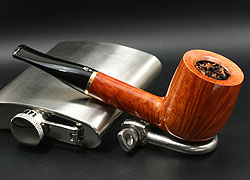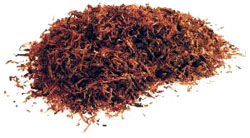
|
The art of pipe smoking |
|
|
|
|
|
|
|
The art of pipe
smoking
 Pipe Pipe
Select a fine pipe. If
you are not an experienced pipe smoker, let yourself be advised by
an expert, like the proprietor of a pipe shop. He has a large
assortment and can, in consulting with you, determine which pipe
would suit you.
Which standards should a pipe
initially meet?
The lighter the pipe and thus,
the easier in the mouth, the less likely it is to taste the full
flavour of the tobacco: the more likely it is to smoke "hot". Try the "draw". It should be very easy. Take a look at the bore hole. If it is not deep enough, it will not be possible to smoke the tobacco completely. When you enter a pipe shop with these points in mind, select a number of pipes, and then make it easy on yourself by just taking the pipe that appeals to tyou.
A wooden pipe should be
brooken-in by its owner. That is to say, on the inside of the bowl a
coat of char should gradually by built up. This layer of carbon
protects the pipe, keeps it burning, and at the same time creates
pleasant aroma.
1.
Select a pipe that suits you: 2. Fill your pipe bit by bit, pressing the tobacco slightly, firmer as the pipe gradually fills up, keeping in mind that the tobacco maintains its resilience. A pipe filled too tightly, will require strong pulling power, and a pipe filled too loosely, will result in fiercely burning tobacco and a hot bowl. (A consequence may be wet smoking and an irritated tongue.) 3. Care for an even burning pipe, Bring, after lighting, the curling tobacco back into the bowl, press lightly and, if necessary, relight. Should your pipe be extinguished during smoking, just remove the layer of ash, and relight the tobacco. Tobacco does not quickly lose its flavour. Use long matches so you have plenty of time to light the tobacco evenly. 4. Smoke in piece and quiet. Fierceful and rapid draws cause a restless fast burning pipe that does not taste nearly as good. Pipe smoking should become a natural extension of the breathing rhythm - unhurried and gentle. This might explain the pipe's mystique. Peace of mind and relaxation are to be transferred to you. 5. Maintain a coin-thick layer of carbon in the bowl. From its first smoke a briar begins to form a coat of carbon within the bowl which will thicken, almost impreceptibly with each subsequent fill. The carbon should not be more than a coin-thick or otherwise you risk cracing the bowl. 6. Use pipe cleaners to keep the pipe clean and dry. Put the pipe aside with the stem upwards. When your pipe is empty, it is better to clean it right away with a cleaner, and set it aside for some hours with a cleaner in the stem. In this way much moistures is absorbed by the cleaner (On the other hand the cleaner should not be left permanently in the stem; a pipe benefits from ventilation.) 7. Re-use the pipe only when it is completely dry. This will explain why regular smokers have a selection of pipes at their disposal; they smoke pipes in rotation. 8. Do not smoke a hot pipe or re-fill one that is still warm. If you need to relight halfway through a pipe, first remove all ash and tamp the remaining tobacco down gently and the light up. But do not to up with new, until you have smoked or emptied out the remaining tobacco. 9. Beyond regular cleaning, a point demanding attention is the occasional need to clear the bowl of excess char. The best method is to use a pipe reamer or smoker's knife. Insert it in the bowl and turn, slowly, stripping off the layer of carbon to the required depth.
10.
Moisturising a new pipe is strictly
speaking not required, yet is not advised against. A pipe can be
moisturised by honey, syrup, rum, whisky, or another flavour you
might prefer. Let this soak overnight into the pipe. How to select a tobacco
Mixtures
As the name implies, various light and
dark tobaccos are mixed according to a proprietary recipe. Types of
Mixtures are: Cavendish Mixtures. Double fermented (a maturing process), cut after pressing. Soft, with varying aromas. From SAIL Natural to Aromatic. Cut semicoarse; cool smoking. Black Cavendish When the greater part of the Mixtures consists of dark fermented tobaccos, like Niemeyer's SAIL Black Cavendish. Increasingly in demand.
Tobacco that under a very high pressuer is made into a cake form, and cut into slices. Is to be rubbed loose before use. Ready Rubbed Like Flake Cut, but rubbed loose by a manufacturing process. Granulated Like Flake Cut, but due to cross cutting (along the length and breadth), small, dicelike pieces of tobacco result, each consisting of a number of pressed leaf parts. Crimp Cut Lightly pressed and short cut tobacco varieties, curled by drying and heating. Curly Cut Alternately, dark and light tobacco leaves are rolled into a string, usually enclosed by an extra light leaf. The pipe smoker cuts a small piece from the string, putting it into his pipe, either rubbed or unrubbed. Navy Cut Presssed tobacco, cit imtop this slices, which are to be crumbled before use. Bibliography: Royal Theodorus Niemeyer B.V. Holland - ,,Blenders of fine Pipe Tobaccos" |
|
|
|
|
|
|
 Initially
a couple of points are well worth bearing in mind; that the lighter
and more fine-cut the tobacco, the easier it will burn and stay
alight . For that reason it is suited for the beginning pipe smoker.
Initially
a couple of points are well worth bearing in mind; that the lighter
and more fine-cut the tobacco, the easier it will burn and stay
alight . For that reason it is suited for the beginning pipe smoker.